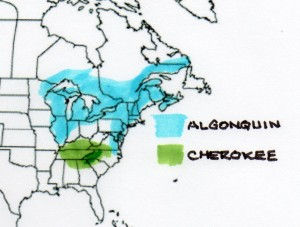Unique Beings Being Unique: Cherokee vs Algonquin
- Courtney Miller
- Apr 24, 2014
- 3 min read

I am constantly struck by the images evoked by the term “Native American”. I find that the English language has a way of sorting and categorizing that often combines very different entities. For instance, the word” love”, in English, refers to both the concept of agape and eros as if they are the same thing. In one case, we are referring to a very unselfish affection, whereas the other is completely selfish.

I think the term “Native American” can be just as contradictory. Certainly, the Native Americans Cherokee house shared some concepts, but I think, when you take a closer look, each Native American tribe was very different and unique. I have written a number of articles showcasing these differences in Native American Antiquity, but today I want to compare two tribes who lived very close to each other in very similar regions—the Cherokee and the Algonquin.
The Cherokee lived primarily in the area we know today as Tennessee, South Carolina, and Georgia. The Algonquin tribes, numbering as many as 100 at one time, were along the Great Lakes, St. Lawrence River, and the Eastern Seaboard from Maine down to Virginia.

The first major difference was language. The Algonquin spoke a language classified today as Algonquin, whereas the Cherokee spoke the entirely different language of Iroquoian. They probably would not have been able to speak to one another.
The Algonquin family structure was patriarchal, opposite that of the matriarchal Cherokee. The Algonquin families were attached to the father’s side of the family. The wife left her family to live with the husband and the sons inherited hunting territories and titles (chief, etc.) from their father. The Cherokee wife was the head of the household and the children belonged to her clan. The husband was obliged to move in with her family or her house and even the responsibility of raising the children fell to her family not her husband.
In Algonquin society, the position of chief was inherited. In Cherokee society, there were two chiefs—a war chief and a peace chief—that were elected or selected based on merit.

Quoting from the Algonquin Anishinabeg Nation’s website, “During the summer, many families would get together for weddings and other common subjects. They were extended families or families that were not related to each other.

During the warm season, people would stay in the same spot or move around the same area. It was the time to gather food in prevision of winter. They would dry meat, gather wild fruits, farm certain plants, find medicine plants, etc. The food would then be used by the families when they traveled to their hunting grounds and last them until the end of November,
when the winter season would start. Winter was a survival and subsisting season.”
During warm weather, The Algonquin lived in temporary, semi portable “wigwams” enabling them the flexibility to move around and follow game or fish migrations. They spent their time out-of-doors and only used the wigwams to sleep or stay warm. Spring was spent planting crops and fishing in coastal waters or rivers using birch-bark canoes and spears. April through October, they hunted migratory birds and gathered berries and harvested crops. Then when the snow came, they congregated in winter camps in sheltered locations where they built “long houses” inside stockade-like walls.

The Cherokee did not travel to do hunting or live in different areas in different seasons. They built permanent, framed housing made of daub and waddle walls with straw roofs and lived in permanent villages where they raised crops and hunted in nearby forests. They also built small, round, domed “asi’s” to use for shelter against the cold. The Cherokee were an agricultural-based society, whereas the Algonquin were more nomadic.
These kinds of differences separated the Native American tribes and made them each unique. On some occasions, they borrowed techniques from their neighbors, but for the most part were independent thinkers creating solutions to fit their own specific circumstances and preferences.

















![Kawoni [April]: The Flower Moon](https://static.wixstatic.com/media/12aa6a_7c3e945d560a42299d136778a994ffa7~mv2.jpg/v1/fill/w_185,h_210,fp_0.50_0.50,lg_1,q_30,blur_30,enc_avif,quality_auto/12aa6a_7c3e945d560a42299d136778a994ffa7~mv2.webp)
![Kawoni [April]: The Flower Moon](https://static.wixstatic.com/media/12aa6a_7c3e945d560a42299d136778a994ffa7~mv2.jpg/v1/fill/w_74,h_84,fp_0.50_0.50,q_90,enc_avif,quality_auto/12aa6a_7c3e945d560a42299d136778a994ffa7~mv2.webp)
![Anvyi [March]: The Windy Moon](https://static.wixstatic.com/media/12aa6a_0119c7402f6f43038527f4d6c2f81970~mv2.jpg/v1/fill/w_183,h_210,fp_0.50_0.50,lg_1,q_30,blur_30,enc_avif,quality_auto/12aa6a_0119c7402f6f43038527f4d6c2f81970~mv2.webp)
![Anvyi [March]: The Windy Moon](https://static.wixstatic.com/media/12aa6a_0119c7402f6f43038527f4d6c2f81970~mv2.jpg/v1/fill/w_74,h_85,fp_0.50_0.50,q_90,enc_avif,quality_auto/12aa6a_0119c7402f6f43038527f4d6c2f81970~mv2.webp)



Comments